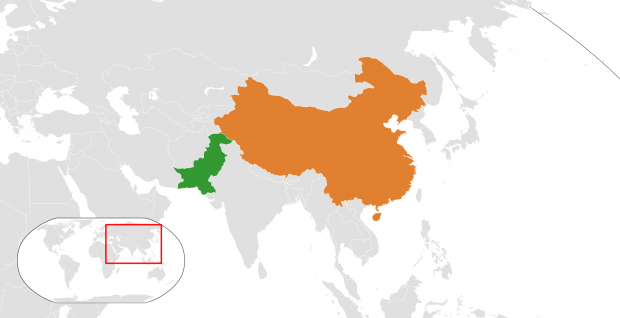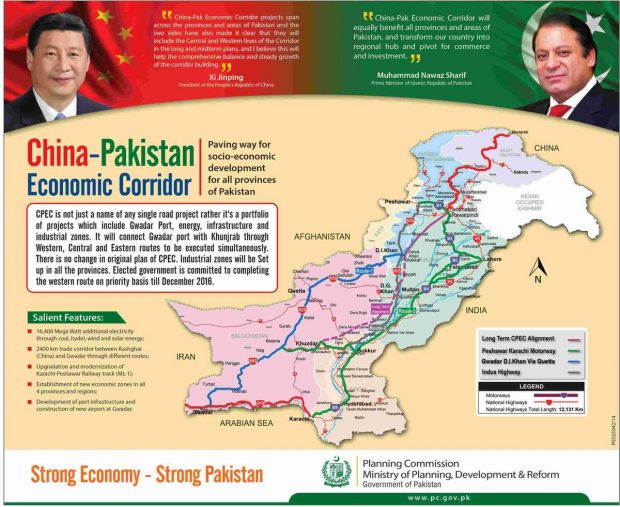Economic Corridor proves ‘Game Changer’ for Pakistan
 In April 2015, Chinese President Xi Jinping was in Islamabad, where he unveiled a $46 billion infrastructure spending blueprint for Pakistan under China Pakistan Economic Corridor (CPEC), to serve as a linchpin of Beijing’s drive to open new trade and transport routes across Asia and challenge the U.S. as the dominant regional power. It all didn’t happen all of sudden. In fact, the efforts were on since many years to materialize the plan. Back in 2008, soon as the Pakistan Peoples’ Party came into power and its leader Asif Ali Zardari assumed the office of country’s President, their government handed over the south-western under-developed Gwadar seaport to China and started negotiations on economic corridor.
In April 2015, Chinese President Xi Jinping was in Islamabad, where he unveiled a $46 billion infrastructure spending blueprint for Pakistan under China Pakistan Economic Corridor (CPEC), to serve as a linchpin of Beijing’s drive to open new trade and transport routes across Asia and challenge the U.S. as the dominant regional power. It all didn’t happen all of sudden. In fact, the efforts were on since many years to materialize the plan. Back in 2008, soon as the Pakistan Peoples’ Party came into power and its leader Asif Ali Zardari assumed the office of country’s President, their government handed over the south-western under-developed Gwadar seaport to China and started negotiations on economic corridor.
Despite decades of mismanagement and a feeble socioeconomic infrastructure, Pakistan does enjoy a strategic location. Among its neighbors, the only one with which Pakistan has maintained cordial ties since independence is China. Enjoying genial relations with a neighbor that is also a major power is clearly a boon for Pakistan.
For China, which has begun to build a presence in multiple regions, Pakistan is a gateway to the Gulf States and Middle East and Africa, where China seeks to showcase its soft power, and develop trade and diplomatic links. Securing a route to the Indian Ocean via the newly developed Pakistani port of Gwadar will do the job nicely, and will also help China develop its presence in the region.
So Beijing’s decision to establish an economic corridor in Pakistan, switching access to the Middle East, Africa and Europe from a lengthy sea route to a much shorter (about 1200 km) road journey is a win-win.
The CPEC will run from the Chinese city of Kashgar to the port of Gwadar in Balochistan province of Pakistan, a deep-sea port that, as stated above, was developed and upgraded by the Chinese, who now have effective control over it. Gwadar is strategically located close to Dubai and Oman. Aware of its importance, China then decided to lay down road (primarily) and air-train networks (gradually). The work on laying network of motorways started without delay and is going on swiftly in all the provinces. Since the Pakistan had already a vast railway network, which links entire country to Karachi, a southern port city in Sindh province, once the part of ancient Silk Route, the expansion of railway link to Gwadar is to take place in phases.
Some political parties in Pakistan however had expressed deep reservations about the CPEC, claiming that the incumbent government of Pakistan Muslim League (Nawaz), having stronghold in Punjab province, is deliberately trying to alter the design of the corridor to favor the constituencies of its own MPs. Similarly, the provincial governments, especially of Sindh and Khyber Pakhtunkhaw provinces, had concerns that CPEC projects are focused only on the development of population-wise bigger province of Punjab. Although the work had swiftly started on infrastructure development in all the areas falling in the ambit of CPEC, the aggrieved provincial governments continued demanding more projects for their provinces through media statements and official meetings.
 Realizing the seriousness of their concerns, the Chinese authorities decided to invite all the Chief Ministers of Pakistani provinces with their proposals to the 6th two-day meeting of Joint Coordination Committee of CPEC in Beijing on December 29-30, 2016.
Realizing the seriousness of their concerns, the Chinese authorities decided to invite all the Chief Ministers of Pakistani provinces with their proposals to the 6th two-day meeting of Joint Coordination Committee of CPEC in Beijing on December 29-30, 2016.
During this meeting, the Chinese side approved support for revival of Karachi’s Circular Railway system to provide transport facility to more than 700,000 commuters every day, which would cost US$2 billion approximately.
Another important project approved there was development of an ancient port known as ‘Keti Bandar’ about 100km east of Karachi and installation of 10,000 MW power park at Keti Bundar along with a transmission line to connect Keti Bundar to other parts of country as well as a railway link from coalfield in Thar Desert to Keti Bundar. The Memorandum of Understanding was also signed in Beijing for this US$5 billion project.
As the Karachi port city is already the country’s largest industrial hub, the Chinese Authorities okayed establishment of a Special Economic Zone at Dhabeji, a place lying between Karachi and proposed new port of Keti Bandar. Similar Special Economic Zones would also be established one each in other provinces also. The Chinese government is now discussing transfer of their surplus industry to these Special Economic Zones in Pakistan.
The initial phase of CPEC projects had so far been the energy, infrastructure and transport but now the Special Economic Zones have emerged as fourth pillar of Chinese regional integration strategy for the development and commercialization support through CPEC.
The provincial government of Sindh has earmarked 1000 acres of land for Special Economic Zone at Dhabeji and is negotiating with the Chinese to develop and relocate their industry at proposed site. All other provinces would follow it and submit commercial viabilities to the China within three months.
Sindh government in collaboration with Chinese companies under the CPEC has already invested billions of dollars on developing coalfield and establishing coal-fired power plants in Thar Desert bordering India. Scores of Chinese engineers along with local engineers and workers are busy in work at these projects in desert, where a big China Town, consisting of containers equipped with all luxurious facilities could be seen spread over a vast area. The families of Chinese engineers too live there as their security has been ensured by raising a Special Force for them.
In view of successful commencement of this project, the CPEC Joint Coordination Committee also decided upgrading the existing block of Thar coalfield and signaled immediate commencement of operations of yet another Thar Coal block to meet the needs of coal-fired power plant being installed in Punjab province, which is owned by a UK company listed on the market in London, and can now attract large equity financing from world class Chinese mining and power companies.
With the recent decisions taken at Joint Coordination Committee in Beijing, the total investment in projects under CPEC has surpassed US$50 billion. After such a successful meeting in Beijing, all the Chief Ministers and the federal government officials returned home fully satisfied.
No doubt the China is making inroads to markets of Asian, African and European markets by developing maritime links through CPEC, it has also proved to a ‘Game Changer’ for Pakistan.






















































